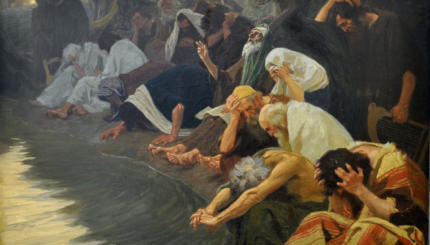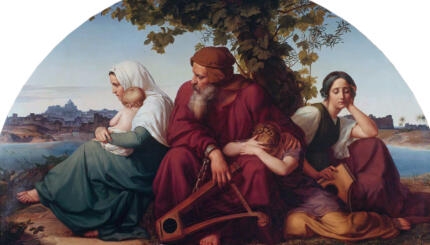Commentary on Parashat Behar, Leviticus 25:1-26:2
Before the sin of Adam and Eve, the earth provided sustenance not through the plotting and plowing of people, but rather through prayer. In the Talmud, the Sage Rav Assi explains that vegetation did not break through the earth until Adam came along and prayed to God to have mercy on the earth. The rains fell and the earth sprouted (Hullin 60b).
The removal of the fruit from the Tree of Knowledge of Good and Evil can be interpreted as a decision to derive pleasure from God’s earth without paying attention to the consequences. As a result, humankind’s working of the land was no longer within the context of safeguarding it. And thus, the earth was cursed, sprouting thorns and thistles, only giving forth its fruit by the sweat of one’s brow.
The Shmita Rules
The commandment of Shmita (the sabbatical year) in the portion of Behar enables a return to the ideal relationship between humankind and creation. The laws relating to the Shmita year are numerous and complex, but there are four general commandments in the from which they are derived.
The first commandment is that the land should rest, as it says “and the land shall rest a to Hashem.” (Leviticus 25:2) Though this commandment is directed at the land, it is humanity’s responsibility to return all of creation to proper relationship with God. When we refrain from planting, pruning, plowing, harvesting, or any other form of working the land, the land is allowed to rest and move towards achieving the union of Shabbat.

Help us keep Jewish knowledge accessible to millions of people around the world.
Your donation to My Jewish Learning fuels endless journeys of Jewish discovery. With your help, My Jewish Learning can continue to provide nonstop opportunities for learning, connection and growth.
The second commandment is to declare all seventh-year produce hefker — ownerless and free for all to take and enjoy. The third general commandment is to sanctify all seventh-year produce. We are prohibited to do any business whatsoever with the produce and obligated to ensure that it is consumed properly and equitably and does not go to waste. The fourth commandment requires us to absolve all loans from one Jew to another in the seventh year.
Moving Away from Materialism
The conscious and meticulous observance of these laws and their rabbinic application can expand our awareness of the true nature of reality. The mandated abstinence from attempting to physically and commercially control the land and the positive commandment to give up all sense of ownership of its produce can free us from the enslavement of the constant pursuit of material goods and the idolatrous illusion that material things serve as a testament to our existence.
Additionally, the sabbatical year provides ample time to contemplate and understand that it is not through the strength or the might of our hand that the earth brings forth its fruits. This not only instills a deeper sense of faith and trust in God, but it allows a shift in how we relate to the earth. The earth must be viewed as a precious gift that has been entrusted to us and therefore we must treat it in a caring and sustainable manner.
Ecosystem Destruction
The inner teachings of the commandment of Shmita are vital today as humankind flirts dangerously with destroying the beautiful world we have been given. One example is the deforestation of vast portions of the earth’s most vital ecosystems in order to support the growing demand for beef.
The “slash and burn” method of clearing land for agriculture, employed globally by both small and large-scale cattle farmers, involves cutting the vegetation of a plot of land and allowing it to dry, at which point it is burned. The land is then cultivated for a few seasons, and eventually abandoned — left fallow for cattle pasture.
Though this process may release nutrients which fertilize the soil, it is only sustainable on a small scale and on nutrient-rich soil. When applied on an industrial level to nutrient-poor soil, like the current situation in the Amazon Rainforest, the result is an ecological disaster.
Richard Robbins writes: “Hundreds of thousands of acres of tropical forests in Brazil, Guatemala, Costa Rica, and Honduras, to name just a few countries, have been leveled to create pasture for cattle. Since most of the forest is cleared by burning, the extension of cattle pasture also creates carbon dioxide, and, according to some environmentalists, contributes significantly to global warming.” (Global Problems and the Culture of Capitalism)
Such operations lead to erosion and remove all nutrients from the soil, leaving it desolate. The result is severe damage to the biodiversity of the rainforest, an increase in the release of carbon dioxide, and general biosphere instability.
Instead of being elevated and sanctified, the earth has become trampled and disgraced. The frightening ecological reality we are facing obligates us to rethink our relationship with the land and the consequences of our actions. Many of our actions may derive pleasure from God’s earth without paying attention to the drastic consequences they have.
Yet even with the damage humanity has caused, Shmita teaches us that we must have faith that God is in control, waiting for us to return from our careless and selfish ways. We must also know that the fluttering of the wings of any change in our relationship with creation on the physical dimension will cause a tornado of movement in the spiritual worlds.
The Water & Rock Episode
The of Shmita provides insight into one of the most puzzling episodes in the Torah. As the Children of Israel prepare themselves in the desert to enter the Land of Israel, the prophetess Miriam passes away and the miraculous source of water that had sustained the people goes dry. God commands Moses to carry out one more miraculous act to instill the true nature of the relationship with the land of Israel deep within the consciousness of the new generation. God tells Moses to speak to the rock to bring forth water.
On this verse, Rav Simcha Meir Cohen of Dvinsk (Eastern Europe, 1843-1926), in his book Meshech Chochmah, explains that God wanted the Children of Israel to experience the Divine Speech flowing through Moses’ mouth, drawing even inanimate objects towards His Will. The intention was for them to “see that which is heard” in a similar manner to the awesome revelation at Mount Sinai where “the entire people saw the Voices (Exodus 20:25).”
This incomprehensible act would significantly strengthen the people’s faith in God’s Providence over all. As a manifestation of this new-found faith, they would also understand that the Holy Land which they were about to enter is not a land that is conquered, used, and abused by the sticks wielded by humans. Rather, the Land of Israel is a celestial land which will pour forth its abundant blessing according to the divine prayers spilling from the lips of the Jewish people, a people who are sensitive and respectful to the needs and nature of all God’s creation.
Moses, possibly shaken by the death of his dear sister and frustrated with the complaints of the people, tragically strikes the rock. God rebukes Moses and Aaron and says “because you did not have faith in Me to sanctify Me in the eyes of the Children of Israel, therefore you will not bring this congregation to the Land that I have given them.” (Numbers 20:12)
Because they failed to express to the people the sanctity of a proper relationship with the Land based on pure faith in God and not human strength, they could not lead the people in.
Awareness of Sinai
When the Torah introduces Shmita, it begins: “God spoke to Moses on Mount Sinai saying (Leviticus 25:1).” Rashi asks: “Why is Shmita mentioned [specifically] by Mount Sinai? Were not all the mitzvot said at Sinai?”
In truth, living a life of Shmita consciousness is a constant reenactment of the receiving of the Torah at Sinai. God gave us the Torah so that we could sanctify and reveal the Truth of all of creation through passionate and dedicated observance of mitzvot.
And so, when we come to proper relationship with the earth and give it rest and respect through the mitzvot of the Shmita year, the awesome splendor of the earth’s divinity is revealed. The sensitive eyes of the caring and enlightened individual will be opened to the radiance of the Divine Speech flowing through all of creation, as it slowly but surely brings the world closer to its perfected state.
Suggested Action Item:
Reduce one beef meal per week, and replace it with a vegetarian dish, kosher organic chicken, or sustainable fish.
This commentary is provided by special arrangement with Canfei Nesharim. To learn more, visit www.canfeinesharim.org.



